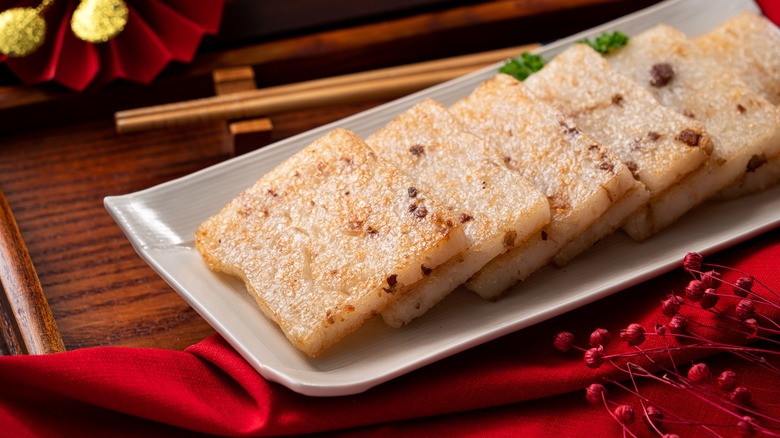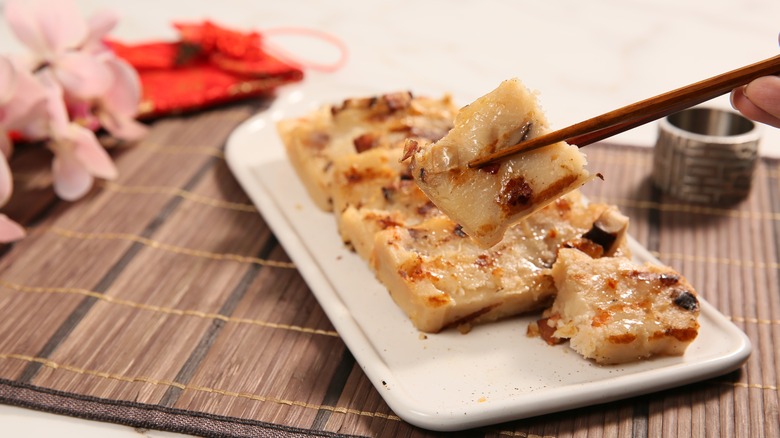Why Turnip Cake Is A Symbolic Food For Lunar New Year
Lunar New Year marks the beginning of the Chinese lunisolar calendar, and this year, the Year of the Dragon begins on Saturday, February 10. Families across China, South Korea, Tibet, Vietnam, Singapore, Indonesia, Taiwan, and Malaysia are gearing up for banquets, firework displays, dancing puppets, red and gold decorations, and more all in the name of welcoming good luck and prosperity in the new year. In fitting decorum, every dish on the traditional Lunar New Year table comes with a unique symbolic meaning. Dumplings symbolize wealth due to their similar shape to gold ingots, an ancient form of Chinese currency. Fa gao, aka fortune cakes, is rippled with cracks across the surface, and the deeper the cracks, the greater your fortune in the coming year. Today, we're deep-diving into one such auspicious dish: turnip cakes.
Contrary to their name, turnip cakes (aka tshài-thâu-kué in Taiwanese and loh bak go in Cantonese) are made from radishes. For reference, turnips taste mildly sweet and earthy compared to radishes' peppery, slightly spicy flavor. Per the lore, the "lucky" association of these humble little cakes is likely a matter of homonyms. In China, the word gāo (糕) meaning "cake" has a similar pronunciation to the word for "rise" or "tall." In Taiwanese, the word chhài-thâu (菜頭) meaning "radish" also sounds like the word for "good fortune." White radish is also commonly called "choi tau" or "cai tou," which sounds like the Chinese word for "good luck."
Speaking good things into existence with every bite
These festive cakes are characterized by their strong taste and sticky texture. Rice flour, grated radish, and tapioca starch are shaped into sticky cakes that are both steamed and fried. This dual-cooking method creates a dense, chewy interior and crispy, crave-able exterior.
Not to be confused with sticky rice cakes (niángāo) which are similar to turnip cakes but served sweet, loh bak go is funky and umami-forward. Turnip cakes also provide a welcome contrast to many other sweeter, richer foods on the Lunar New Year dining table as a savory pudding-like dish with a fresh element from the white radish. Chinese white turnips and Japanese daikon radishes are often used interchangeably to make this dish.
Other flavorful ingredients are also often incorporated into the turnip cakes such as Chinese sausage, shiitake mushroom, dried shrimp, and fried shallot. To serve, they're popularly dipped in oyster sauce or hot chili oil and garnished with chopped chives. The ingredients can all be found at your local Chinese supermarket or specialty grocery store.
On a utilitarian note, turnip cakes also make sense during the winter months because radishes are seasonal winter produce and rice is available year-round. Perhaps that's part of the reason why foodies can find turnip cakes as a permanent fixture in their dim sum spreads. It isn't uncommon for families in Taiwan to serve turnip cakes year-round, especially for breakfast and dessert.

